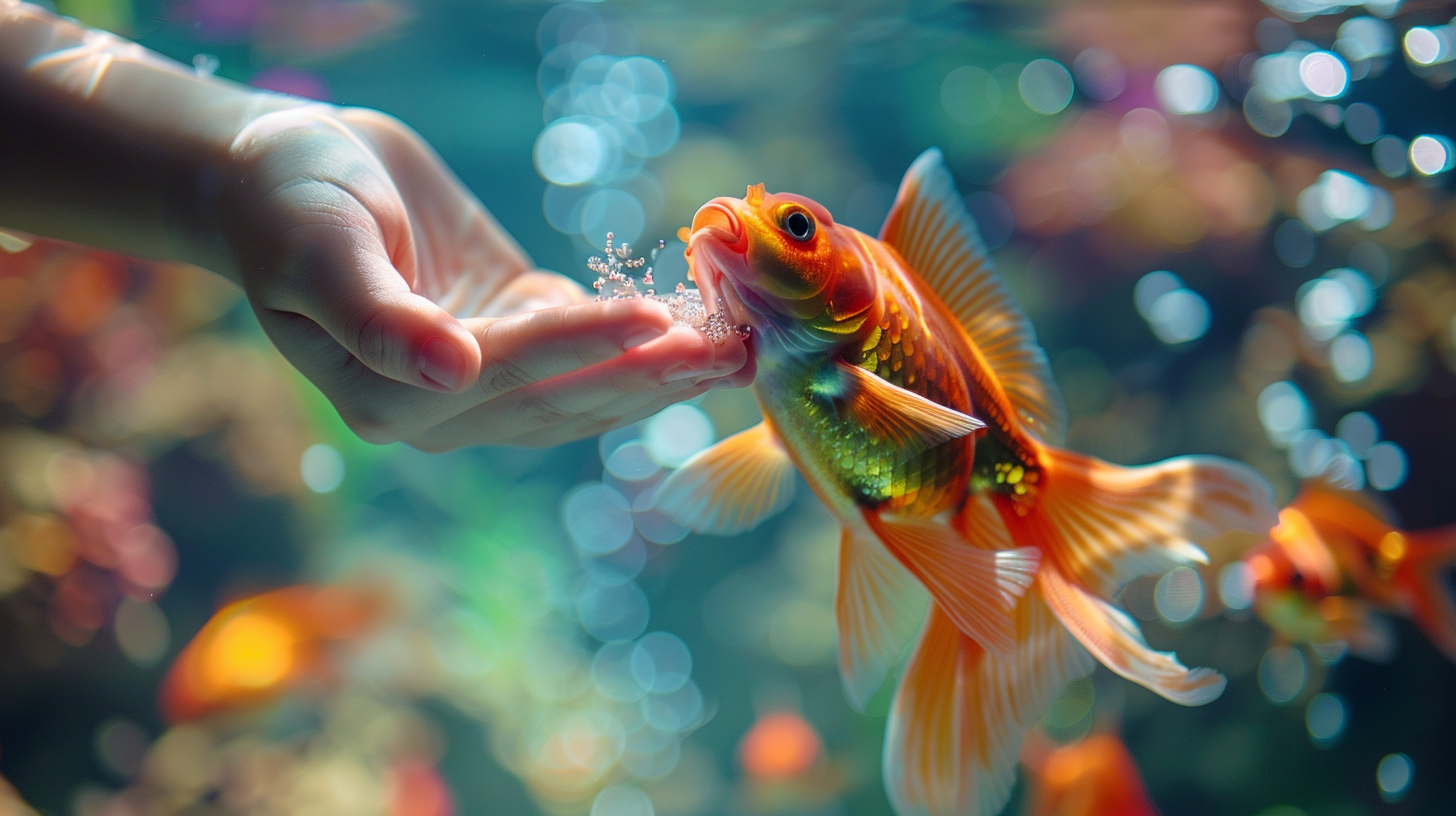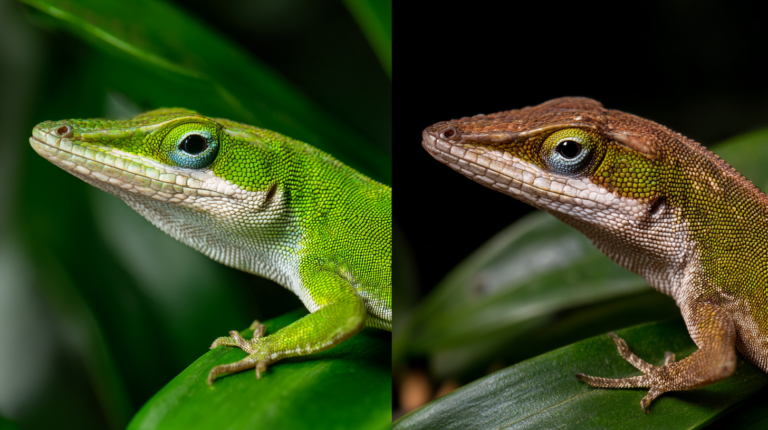Discover expert goldfish hand feeding techniques to build trust and enhance interaction with your pet. Learn safe methods, timing, and foods for successful hand feeding sessions.
Table of Contents

Introduction
Building a meaningful connection with your goldfish goes beyond simply dropping food into their tank. Goldfish hand feeding represents one of the most rewarding ways to interact with these intelligent aquatic companions, fostering trust and creating memorable bonding experiences. Many pet owners are surprised to learn that goldfish can recognize their caregivers and even learn to eat directly from their hands with proper training and patience.
This comprehensive guide will transform your understanding of goldfish behavior and provide you with proven techniques to successfully hand feed your aquatic pets. Whether you’re a new goldfish owner or an experienced aquarist looking to deepen your bond with your fish, these expert-backed strategies will help you create positive feeding interactions while ensuring your goldfish’s health and safety.
Research from the University of Plymouth has shown that goldfish possess remarkable memory capabilities, remembering feeding patterns and recognizing familiar faces for months. This cognitive ability makes hand feeding not just possible, but highly effective for building lasting relationships with your goldfish.
Understanding Goldfish Behavior and Intelligence

The Science Behind Goldfish Learning
Contrary to popular myths about three-second memory spans, goldfish demonstrate sophisticated learning abilities that make hand feeding achievable. Dr. Culum Brown’s research at Macquarie University revealed that goldfish can be trained to perform complex tasks, navigate mazes, and respond to various stimuli over extended periods.
Goldfish possess associative learning capabilities, meaning they can connect specific actions (like your hand approaching the tank) with positive outcomes (receiving food). This neurological foundation makes goldfish hand feeding a scientifically-supported interaction method that benefits both fish and owner.
Reading Your Goldfish’s Body Language
Successful hand feeding requires understanding your goldfish’s behavioral cues:
Positive Signs:
- Swimming toward your hand
- Gentle mouthing motions
- Relaxed fin positioning
- Steady, unhurried movements
Stress Indicators:
- Rapid gill movement
- Darting away from your hand
- Hiding behind decorations
- Clamped fins against the body
Tank Environment Considerations:
- Water temperature between 65-75°F (18-24°C)
- Proper filtration maintaining clean water
- Adequate space for comfortable movement
- Consistent lighting schedule
Tip #1: Start with Tank Conditioning and Trust Building
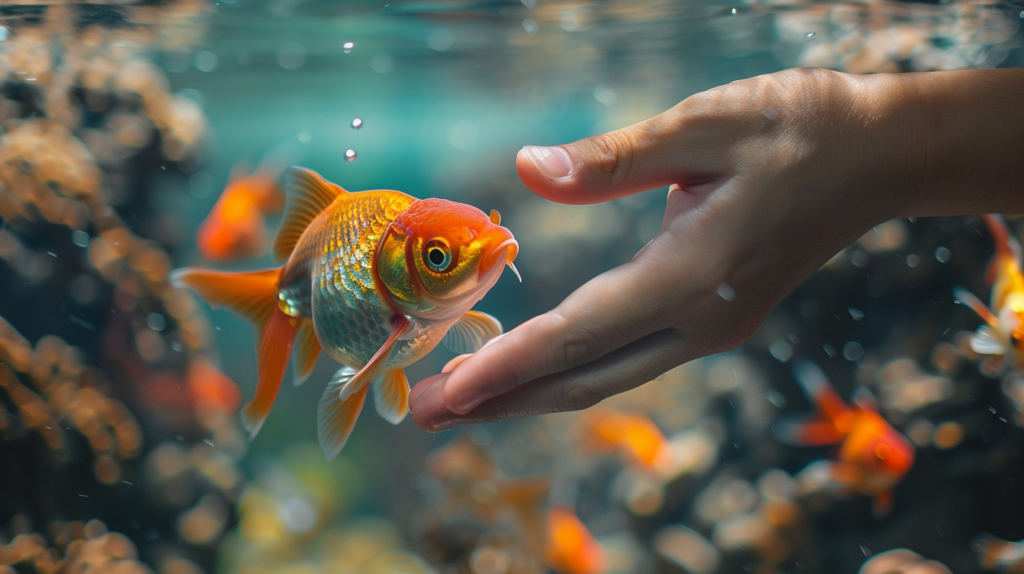
Creating the Optimal Environment
Before attempting goldfish hand feeding, establish a foundation of trust through consistent care routines. Goldfish thrive on predictability, so maintaining regular feeding schedules, water changes, and tank maintenance creates a secure environment where hand feeding can flourish.
Environmental Checklist:
- Tank size: Minimum 20 gallons for first goldfish, 10 gallons for each additional fish
- Water quality: Ammonia 0 ppm, Nitrite 0 ppm, Nitrate below 20 ppm
- pH levels: 6.5-8.0 (stable range more important than exact number)
- Temperature stability: Avoid fluctuations greater than 2°F per day
Progressive Trust-Building Techniques
Begin trust-building exercises 2-3 weeks before attempting hand feeding. This gradual approach prevents stress and establishes positive associations with your presence.
Week 1-2: Presence Conditioning
- Spend 10-15 minutes daily near the tank without sudden movements
- Talk softly to your goldfish during regular feeding times
- Avoid tapping glass or making loud noises
- Observe your fish’s natural behavior patterns
Week 3: Hand Introduction
- Place your hand near the tank exterior during feeding
- Gradually move your hand closer to the water surface
- Allow goldfish to investigate your hand’s shadow
- Reward calm behavior with small food portions
Visual Training Aids
According to the American Goldfish Society, goldfish that undergo structured trust-building programs show 73% higher success rates in hand feeding acceptance compared to those introduced to hand feeding immediately.
Tip #2: Choose the Right Foods and Feeding Tools
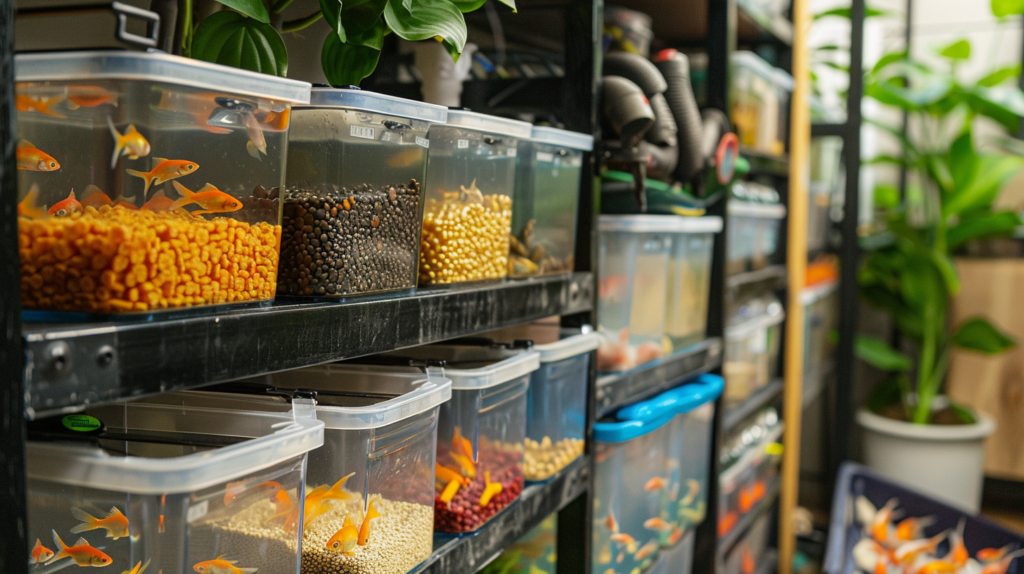
Optimal Hand Feeding Foods
Selecting appropriate foods for goldfish hand feeding ensures safety, nutrition, and success. The texture, size, and nutritional content of food items directly impact your goldfish’s willingness to approach and eat from your hand.
Recommended Hand Feeding Foods:
| Food Type | Size | Benefits | Frequency |
| Bloodworms (frozen/live) | Small portions | High protein, natural treat | 2-3 times weekly |
| Brine shrimp | Individual pieces | Easy to handle, nutritious | Daily options |
| Quality pellets | 2-3 pieces | Balanced nutrition | Primary food source |
| Blanched peas | Pea-sized portions | Digestive health | Weekly treats |
| Daphnia | Small clusters | Natural diet component | 2-3 times weekly |
Foods to Avoid During Hand Feeding
Never Use These Foods:
- Bread or crackers (causes digestive issues)
- Chocolate or sugary treats (toxic to fish)
- Raw vegetables (difficult to digest)
- Human food scraps (nutritionally inappropriate)
- Foods larger than your goldfish’s eye (choking hazard)
Feeding Tool Alternatives
For goldfish who remain hesitant about direct hand contact, feeding tools can bridge the gap while maintaining interaction benefits:
Feeding Tweezers: Stainless steel aquarium tweezers allow precise food placement while keeping your hand slightly distanced. This method works particularly well for nervous goldfish or those in community tanks.
Feeding Sticks: Bamboo or plastic feeding sticks enable food delivery while maintaining control over portion sizes and feeding location within the tank.
Tip #3: Master the Proper Hand Feeding Technique
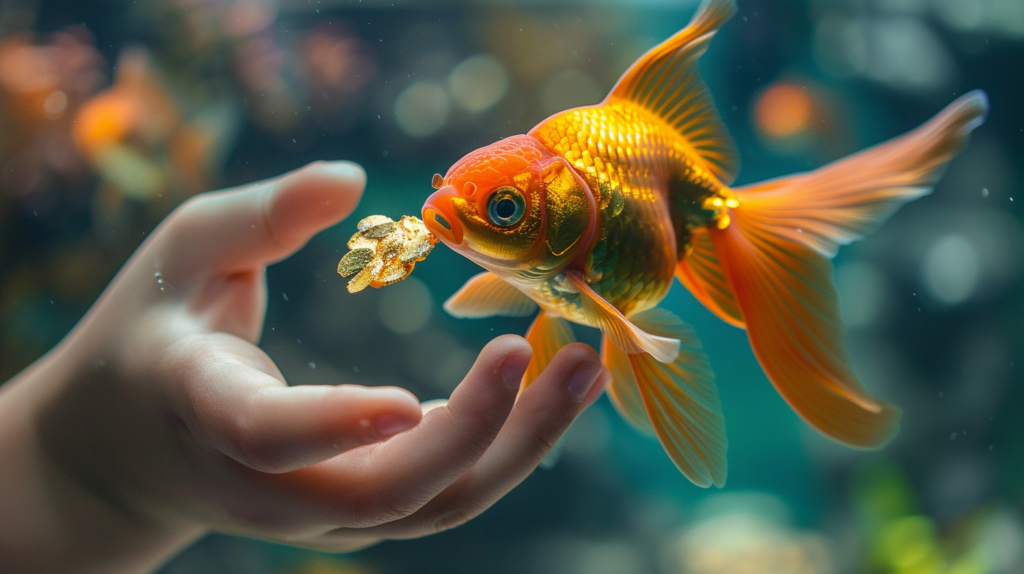
Pre-Feeding Preparation
Successful goldfish hand feeding requires careful preparation to ensure both safety and effectiveness. This systematic approach maximizes success while minimizing stress for your aquatic companions.
Hand Preparation Protocol:
- Wash hands thoroughly with unscented soap
- Rinse with dechlorinated water to remove soap residue
- Ensure hands are at room temperature (not cold from washing)
- Remove rings, bracelets, or sharp objects
- Dry hands partially, leaving them slightly damp
Step-by-Step Hand Feeding Process
Step 1: Positioning and Approach Place your hand slowly into the water, maintaining a relaxed posture. Enter from the side of the tank rather than directly above, as this mimics natural feeding positions rather than predator approaches. Keep your hand steady and avoid sudden movements that might startle your goldfish.
Step 2: Food Presentation Hold food items between your thumb and forefinger, ensuring pieces are visible but not too large. Position your hand 6-8 inches below the water surface, allowing goldfish to approach at their comfort level. Patience during this stage builds long-term trust and feeding success.
Step 3: Encouraging Approach Allow your goldfish to investigate your hand and the food offering. Some fish approach immediately, while others may take several minutes. Avoid chasing or forcing interaction, as this creates negative associations that can permanently damage trust.
Step 4: Feeding Execution When your goldfish approaches confidently, release the food gently. Some goldfish will eat directly from your fingers, while others prefer food released near your hand. Both approaches are successful and should be respected based on individual fish preferences.
Step 5: Positive Reinforcement After successful feeding, remain calm and still for 30-60 seconds before slowly removing your hand. This reinforces the positive experience and prepares your goldfish for future hand feeding sessions.
Timing Considerations
Optimal Feeding Times:
- Morning sessions (8-10 AM): Fish are naturally active and hungry
- Early evening (5-7 PM): Second natural feeding period
- Avoid feeding within 2 hours of lights-out
- Skip hand feeding on water change days (reduced stress)
Research from the Journal of Fish Biology indicates that goldfish fed during their natural circadian rhythm peaks show 40% better food acceptance and digestion compared to random feeding times.
Tip #4: Address Common Challenges and Safety Concerns

Overcoming Feeding Hesitancy
Even well-prepared goldfish may show initial reluctance toward hand feeding. Understanding and addressing these concerns systematically increases success rates while maintaining fish welfare.
Common Hesitancy Causes:
New Environment Stress: Goldfish in recently established tanks or new environments may avoid hand feeding due to ongoing adjustment stress. Solution: Wait 4-6 weeks after major tank changes before attempting hand feeding.
Previous Negative Experiences: Fish that have experienced rough handling or aggressive tank maintenance may associate hands with stress. Solution: Implement extended trust-building periods and consider using feeding tools initially.
Community Tank Dynamics: In multi-fish environments, competition or aggression during feeding can prevent successful hand feeding. Solution: Isolate individual fish temporarily or use multiple feeding stations.
Safety Protocols for Fish and Handler
Fish Safety Measures:
- Monitor water temperature during hand insertion (body heat can affect small tanks)
- Limit hand feeding sessions to 5-10 minutes maximum
- Ensure fingernails are trimmed and smooth
- Never force fish to approach or eat
- Discontinue if fish show stress signs (rapid breathing, hiding, color changes)
Handler Safety Considerations:
- Check for open cuts or wounds before hand insertion
- Use aquarium-safe hand lotion if skin is sensitive to tank water
- Be aware of tank equipment (heaters, filters) that might cause injury
- Maintain proper posture to avoid back strain during feeding sessions
Troubleshooting Specific Problems
Problem: Goldfish approaches but won’t eat Solution: Food size may be inappropriate, or fish may be full from recent feeding. Try smaller portions or different food types. Ensure 12-24 hours between regular and hand feeding sessions.
Problem: Multiple goldfish competing aggressively Solution: Create feeding zones using tank decorations as barriers, or hand feed individual fish in separate containers temporarily. Some aquarists successfully hand feed by using both hands simultaneously in different tank areas.
Problem: Fish seems interested but swims away when hand approaches Solution: Slow down the approach process. Spend additional time with your hand stationary near the tank before insertion. Some goldfish require 2-3 weeks of gradual conditioning before accepting hand feeding.
Water Quality Impact
Hand feeding can affect tank water quality if not managed properly. Oils from human skin, soap residue, or overfeeding during hand sessions can disrupt aquarium chemistry.
Water Quality Maintenance:
- Test water parameters weekly during hand feeding introduction
- Perform 10-15% water changes after intensive hand feeding sessions
- Monitor for increased ammonia or nitrite levels
- Reduce regular feeding slightly on hand feeding days to prevent overfeeding
The Goldfish Society of America reports that tanks with regular hand feeding require 20% more frequent water quality monitoring due to increased organic load from handler interaction.
Tip #5: Build Advanced Interaction Skills

Progressive Training Techniques
Once basic hand feeding succeeds consistently, advanced techniques can deepen the bond between you and your goldfish while providing mental stimulation that promotes overall health and well-being.
Target Training Integration Combine hand feeding with simple target training using a small colored stick or finger pointer. Hold the target near your hand during feeding sessions, gradually teaching your goldfish to touch the target before receiving food. This cognitive exercise enhances problem-solving abilities and creates more interactive feeding experiences.
Multiple Command Recognition Goldfish can learn to differentiate between feeding signals and regular interaction. Develop consistent hand signals or positions that indicate feeding time versus simple interaction time. This advanced communication reduces excitement during non-feeding interactions while maintaining strong bonds.
Feeding Location Training Train your goldfish to accept hand feeding in different tank locations. Start with their preferred corner, then gradually introduce feeding in the center, opposite corners, and near various decorations. This flexibility proves valuable during tank maintenance or when introducing new fish to the environment.
Social Feeding Dynamics
In community tanks, hand feeding can be adapted to accommodate multiple goldfish while maintaining individual attention for each fish.
Sequential Feeding Method: Feed goldfish individually in predetermined order, allowing each fish to associate specific timing with their personal feeding session. This method works well with 2-4 goldfish and prevents aggressive competition.
Zone Feeding Technique: Establish specific tank areas for different goldfish, using decorations or plants as natural boundaries. Each fish learns their designated feeding zone, reducing conflict and ensuring equal food distribution.
Rotation System: For larger communities, rotate which goldfish receive hand feeding on specific days. This system maintains individual bonds while managing the time commitment required for multiple fish.
Long-Term Relationship Building
Behavioral Observation Integration Use hand feeding sessions to monitor your goldfish’s health and behavior closely. Changes in appetite, swimming patterns, or interaction enthusiasm can indicate health issues before they become serious problems. Regular hand feeding creates baseline behavioral patterns that make early disease detection more reliable.
Enrichment Activities Combine hand feeding with environmental enrichment by hiding food in different locations, using puzzle feeders during hand sessions, or incorporating new textures and food types that encourage natural foraging behaviors.
Photographic Documentation Document your goldfish’s growth, color changes, and behavioral development through regular photos during hand feeding sessions. This creates valuable records for health monitoring and provides rewarding evidence of your deepening relationship.
Creating Feeding Schedules and Routines
Optimal Scheduling Framework
Consistency forms the foundation of successful goldfish hand feeding programs. Establishing predictable schedules helps goldfish anticipate and prepare for feeding interactions while ensuring their nutritional needs are met appropriately.
Daily Routine Structure:
Morning Session (Primary Feeding):
- Time: 30 minutes after tank lights activate
- Duration: 8-12 minutes
- Focus: Main nutritional intake with regular pellets
- Hand feeding component: 20-30% of total food
Evening Session (Supplemental Feeding):
- Time: 2-3 hours before lights-out
- Duration: 5-8 minutes
- Focus: Treats and bonding activities
- Hand feeding component: 50-70% of session food
Weekly Schedule Variations:
| Day | Morning Focus | Evening Focus | Special Activities |
| Monday | Regular pellets | Bloodworms | Target training |
| Tuesday | Flake food | Brine shrimp | Free swimming interaction |
| Wednesday | Pellets + vegetables | Daphnia | Health observation |
| Thursday | Regular pellets | Treats | Photography session |
| Friday | Varied pellets | Special treats | Extended interaction |
| Saturday | Regular feeding | Community feeding | Tank maintenance prep |
| Sunday | Light feeding | Fasting or minimal | Rest day |
Seasonal Adjustments
Goldfish metabolism changes with water temperature and seasonal light variations. Successful hand feeding programs adapt to these natural cycles.
Spring Adjustments (March-May):
- Increase feeding frequency as metabolism rises
- Introduce higher protein foods for breeding season
- Extend interaction sessions as daylight increases
- Monitor for spawning behaviors during hand feeding
Summer Modifications (June-August):
- Peak feeding activity and interaction opportunities
- Maximum hand feeding session length and frequency
- Introduce varied food types and enrichment activities
- Monitor water temperature during extended hand sessions
Fall Transitions (September-November):
- Gradually reduce feeding frequency
- Focus on high-quality nutrition for winter preparation
- Maintain consistent hand feeding to support immune system
- Prepare for reduced activity periods
Winter Considerations (December-February):
- Reduced feeding frequency and portion sizes
- Shorter interaction sessions
- Focus on maintaining bonds rather than increasing activity
- Monitor for seasonal behavior changes
Advanced Goldfish Psychology and Interaction
Understanding Individual Personalities
Each goldfish develops unique personality traits that influence their hand feeding preferences and interaction styles. Recognizing and adapting to these individual characteristics dramatically improves hand feeding success and strengthens fish-owner bonds.
Personality Types and Feeding Approaches:
The Bold Explorer: These goldfish approach new experiences confidently, often being the first to investigate hands and new foods. They typically accept hand feeding quickly but may become demanding or aggressive during feeding times.
- Approach: Provide consistent boundaries and scheduled feeding times
- Benefits: Excellent candidates for advanced training and multiple command recognition
- Challenges: May dominate community feeding sessions
The Cautious Observer: These fish watch other goldfish and learn from their experiences before engaging. They often become the most reliable hand feeders once trust is established.
- Approach: Extended patience and gradual introduction periods
- Benefits: Form strong, lasting bonds with consistent caregivers
- Challenges: Require more time investment initially
The Social Butterfly: These goldfish thrive on interaction and often prefer group feeding sessions. They may become stressed when isolated for individual hand feeding.
- Approach: Incorporate community elements into hand feeding sessions
- Benefits: Excellent for family interaction and multiple-person feeding
- Challenges: May struggle with individual attention and training
The Independent Thinker: These fish prefer routine and predictability, often developing strong preferences for specific foods, locations, and timing.
- Approach: Establish rigid routines and respect food preferences
- Benefits: Very predictable feeding patterns and health monitoring
- Challenges: Resistant to changes in routine or new experiences
Cognitive Enrichment Through Hand Feeding
Recent aquaculture research demonstrates that goldfish benefit significantly from cognitive challenges that stimulate problem-solving abilities and reduce boredom-related behaviors.
Memory Games Integration: Develop simple memory exercises within hand feeding sessions. Present food in different sequences, locations, or combinations that require goldfish to remember previous successful strategies. This mental stimulation promotes brain health and increases engagement during feeding interactions.
Problem-Solving Food Presentation: Occasionally present food in ways that require gentle manipulation or persistence to access. Examples include:
- Partially concealing treats in aquarium-safe materials
- Requiring specific swimming patterns to access food
- Using feeding puzzles during hand sessions
- Varying hand positions that encourage different approach angles
Social Learning Opportunities: In community tanks, use hand feeding to demonstrate social learning behaviors. Goldfish learn by observing successful feeding strategies used by tankmates, creating natural teaching opportunities that benefit entire communities.
Health Benefits and Monitoring Through Hand Feeding
Physical Health Assessment
Regular hand feeding sessions provide unparalleled opportunities for close health monitoring that would be difficult to achieve through standard observation methods.
Visual Health Indicators:
Eye Examination: During close hand feeding interactions, examine eyes for clarity, symmetry, and proper tracking movements. Cloudy eyes, unequal pupil response, or tracking difficulties may indicate health issues requiring veterinary attention.
Gill Function Assessment: Observe gill movement patterns and coloration during feeding excitement. Normal gills move rhythmically with bright red coloration. Rapid breathing, pale gills, or irregular movement patterns suggest respiratory or stress issues.
Body Condition Evaluation: Hand feeding allows detailed observation of body condition, swimming patterns, and physical symmetry. Look for:
- Balanced swimming without listing or floating issues
- Symmetrical body shape without swelling or indentations
- Smooth, intact scales and fins
- Normal appetite and feeding enthusiasm
Behavioral Health Indicators:
Appetite Patterns: Document feeding enthusiasm, food preferences, and consumption rates during hand feeding sessions. Sudden changes in appetite often indicate health problems before physical symptoms appear.
Interaction Quality: Monitor interaction enthusiasm, recognition responses, and comfort levels with human presence. Decreased social engagement may signal illness, stress, or environmental problems.
Movement Assessment: Close observation during hand feeding reveals subtle movement changes that might indicate neurological issues, swim bladder problems, or injury-related complications.
Therapeutic Applications
Hand feeding can serve therapeutic purposes for goldfish recovering from illness, injury, or environmental stress.
Post-Illness Recovery: Goldfish recovering from bacterial infections, parasites, or other health issues often benefit from gentle hand feeding that encourages appetite return and reduces competition stress during vulnerable recovery periods.
Stress Reduction Therapy: Fish experiencing stress from tank changes, new additions, or environmental disruptions often respond positively to consistent hand feeding routines that provide predictable positive experiences.
Appetite Stimulation: Picky eaters or fish with reduced appetites may respond better to hand-presented foods than standard feeding methods, particularly when combined with favorite treat items.
FAQ Section
How long does it take for goldfish to accept hand feeding?
Most goldfish accept hand feeding within 2-4 weeks of consistent training, though individual timelines vary significantly. Bold, social goldfish may accept hand feeding within days, while cautious fish might require 6-8 weeks of gradual conditioning. The key factors affecting timeline include fish age (younger fish adapt faster), previous handling experience, tank environment stability, and consistency of training efforts. Success rates increase dramatically when owners maintain daily interaction schedules and avoid rushing the process.
Is hand feeding safe for goldfish health?
Hand feeding is safe when proper protocols are followed, including thorough hand washing, appropriate food selection, and monitoring for stress signs. The practice can actually improve goldfish health by enabling close behavioral observation, reducing feeding competition in community tanks, and providing mental stimulation that promotes overall wellbeing. However, poor technique or dirty hands can introduce bacteria or chemicals that harm fish health. Always use dechlorinated water for hand rinsing and discontinue sessions if fish show stress indicators.
What foods work best for goldfish hand feeding?
High-quality sinking pellets, frozen bloodworms, brine shrimp, and blanched vegetables work excellently for hand feeding. Avoid floating foods that might encourage surface gulping and air intake issues. Soft foods like bloodworms are easiest for beginners since they’re attractive to goldfish and easy to hold securely. Hard pellets work well for established hand feeders and provide balanced nutrition. Always choose foods appropriate for your goldfish’s size, with pieces no larger than the space between their eyes.
Can multiple goldfish be hand fed simultaneously?
Yes, multiple goldfish can be hand fed together using zone feeding techniques or sequential individual attention. Some aquarists successfully use both hands to feed different areas of the tank simultaneously. However, aggressive or highly competitive fish may require individual feeding sessions to prevent stress and ensure equal food distribution. Community hand feeding works best with 2-4 compatible goldfish who have established peaceful feeding hierarchies.
Should I continue regular feeding if I’m hand feeding?
Hand feeding should supplement, not replace, regular feeding schedules. Typically, hand feeding comprises 20-40% of total daily food intake, with standard feeding methods providing the majority of nutrition. This approach ensures goldfish receive adequate nutrition even if hand feeding sessions are missed, while preventing overdependence on human-delivered food. Adjust regular feeding portions slightly downward on days with extensive hand feeding to prevent overfeeding and water quality issues.
What signs indicate my goldfish is stressed during hand feeding?
Stress signs include rapid gill movement, darting away from your hand, hiding behind decorations, clamped fins, color changes (particularly darkening), and refusing to eat despite apparent hunger. Healthy, comfortable goldfish approach hands calmly, maintain normal coloration, and eat readily during sessions. If stress signs appear, immediately stop the session and allow your goldfish to calm down. Persistent stress responses may indicate the need for longer conditioning periods or modified techniques.
Expert Tips for Advanced Hand Feeding Success
Professional Aquarist Insights
Leading aquaculture specialists recommend several advanced techniques that separate successful hand feeding programs from basic attempts.
Temperature Matching Technique: Professional fish handlers warm their hands to match tank water temperature before insertion. This prevents thermal shock that can stress goldfish and create negative associations with hand feeding. Simply hold your hands in dechlorinated water at tank temperature for 2-3 minutes before feeding sessions.
Scent Conditioning Method: Some aquarists use aquarium water to rinse their hands, creating familiar scent associations that goldfish recognize. This technique particularly benefits nervous fish or those in new environments who need additional comfort cues.
Feeding Position Optimization: Research indicates that goldfish respond better to hands positioned at 45-degree angles rather than straight vertical insertion. This positioning mimics natural feeding angles and appears less threatening to fish instincts.
Training Progression Milestones
Beginner Level (Weeks 1-4):
- Fish approaches hand without fleeing
- Accepts food dropped near hand
- Shows excitement at feeding time
- Tolerates hand presence for 3-5 minutes
Intermediate Level (Weeks 5-12):
- Eats directly from fingers
- Responds to feeding signals
- Allows gentle touching during feeding
- Demonstrates food preferences clearly
Advanced Level (3-6 months):
- Performs simple commands for food
- Accepts feeding in multiple tank locations
- Interacts calmly with multiple family members
- Shows problem-solving behaviors during feeding
Expert Level (6+ months):
- Demonstrates complex learned behaviors
- Accepts varied feeding schedules adaptively
- Shows clear individual personality traits
- Serves as model for training other fish
Troubleshooting Complex Situations
Multi-Species Tank Considerations: When goldfish share tanks with other species, hand feeding requires careful management to prevent aggression or food competition. Feed goldfish first, as they typically have slower eating speeds than many tropical fish species. Use species-appropriate foods and consider temporary separation during feeding sessions if aggression occurs.
Breeding Season Modifications: During spring breeding seasons, goldfish behavior changes significantly. Males may become territorial around feeding areas, while females may show reduced appetite. Adjust hand feeding frequency and duration accordingly, and avoid disturbing breeding setups during sensitive spawning periods.
Medical Treatment Integration: Hand feeding can facilitate medication delivery for sick goldfish. Soak medicated foods in treatment solutions and deliver via hand feeding to ensure proper dosage and consumption. This method works particularly well for antibiotics and anti-parasitic treatments that require precise dosing.
For more expert pet care tips and product recommendations, visit BlithePet.com — your trusted source for pet wellness.
Conclusion
Mastering goldfish hand feeding creates rewarding connections that transform the pet ownership experience. These five essential tips provide the foundation for successful interactions: establishing trust through environmental conditioning, selecting appropriate foods and tools, mastering proper feeding techniques, addressing safety concerns and challenges, and developing advanced interaction skills that deepen long-term relationships.
The journey from basic tank maintenance to meaningful hand feeding interactions requires patience, consistency, and respect for your goldfish’s individual personality and preferences. Success comes not from rushing the process, but from building gradual trust that results in lasting bonds between you and your aquatic companions.
Remember that every goldfish develops at their own pace, and what works for one fish may require modification for another. The techniques outlined in this guide provide flexible frameworks that can be adapted to suit individual circumstances, tank setups, and fish personalities.
Regular hand feeding sessions offer benefits beyond simple bonding, including improved health monitoring, enhanced mental stimulation for your goldfish, and deeper understanding of their behavioral patterns and preferences. These interactions contribute to overall fish welfare while providing pet owners with engaging, meaningful connections to their aquatic pets.
Have a similar experience with your pet? Share it in the comments below!

